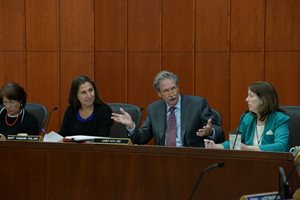 Developing the region’s transit system and supporting TOD is a regional effort. There are many ways that different levels of government are involved in improving connections to transit and creating choices for living and working near transit. These roles range from developing broad policies to constructing new sidewalks. This section of the TOD Guide covers the roles of the Metropolitan Council, counties, and cities. More often than not, these efforts are collaborations among people with different knowledge and expertise of land use planning, urban design, transportation planning, traffic engineering, civil engineering, and real estate.
Developing the region’s transit system and supporting TOD is a regional effort. There are many ways that different levels of government are involved in improving connections to transit and creating choices for living and working near transit. These roles range from developing broad policies to constructing new sidewalks. This section of the TOD Guide covers the roles of the Metropolitan Council, counties, and cities. More often than not, these efforts are collaborations among people with different knowledge and expertise of land use planning, urban design, transportation planning, traffic engineering, civil engineering, and real estate.
Roles of Government
Government roles related to TOD include policies on land use and transportation, designing and building infrastructure, engaging community groups, providing financial resources, and regulating development. TOD is a special focus because of the large public investment in transit, the special needs of people who rely on transit, and the desire to create places around transit where people want to live, work, and invest.
Roles include:
-
Building and operating transit that improves mobility and provides access to existing and future development.
-
Connecting people to transit though local infrastructure like sidewalks and bicycle facilities.
-
Using public funds and financing to support redevelopment, housing opportunities, and job opportunities.
-
Working with communities to identify specific goals for TOD (e.g., improved streetscape, more housing options) and identifying the means to implement these goals.
Roles of Non-Governmental Organizations
Organizations outside of government, like the Urban Land Institute, Local Initiatives Support Corporation, and Central Corridor Funders Collaborative, also support TOD. They help government strategize and prioritize efforts in support of TOD. These efforts include education, analysis, and advocacy on topics like development feasibility, urban design, racial/economic equity, community development, or housing needs. In some cases, they help fund planning efforts or projects. Although non-governmental organizations play critical roles, the focus of this section is to provide a comprehensive understanding of the roles that government plays in support of TOD.